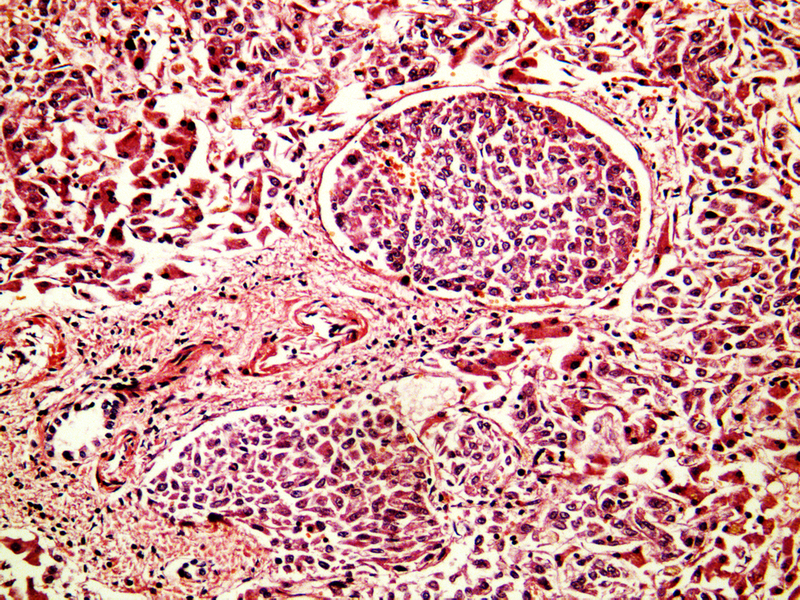Ramucirumab effective irrespective of prior TACE in advanced HCC with elevated AFP
ESMO 21st World Congress on Gastrointestinal Cancer Newsroom Jul 10, 2019
Ramucirumab improves survival for patients with advanced hepatocellular carcinoma (HCC) and elevated alpha-fetoprotein (AFP) regardless of prior transarterial chemoembolization (TACE) treatment, according to a post-hoc analysis of REACH/REACH-2 presented at the ESMO 21st World Congress on Gastrointestinal Cancer.

Patients with localized HCC, preserved liver function, and good performance status (PS) frequently receive locoregional treatment with TACE, which has been shown to prolong overall survival (OS). However, these patients have high rates of recurrence and require subsequent systemic therapy. Furthermore, patients with elevated AFP have a poorer prognosis compared with the general HCC population.
REACH and REACH-2 studied ramucirumab, an anti-VEGFR2 antibody, in patients with HCC following sorafenib, with REACH-2 only enrolling patients with baseline AFP ≥400 ng/mL. The latter study met its primary endpoint of overall survival (OS) for ramucirumab treatment compared to placebo, consistent with the outcomes for the patient population with elevated AFP in the REACH study. A subsequent meta-analysis of individual patient data from the pooled population from both studies confirmed that ramucirumab has a significant and clinically meaningful benefit in patients with baseline AFP ≥400 ng/mL.
To determine the effect of prior TACE treatment on outcomes with ramucirumab in the same pooled population, a global team of researchers conducted a post-hoc analyses. The pooled analysis increased the patient population size, enabling a more precise assessment of the treatment effect by prior TACE. Tim Meyer, Royal Free Hospital, University College London, UK, presented the findings.
Patients with advanced HCC, Child-Pugh A, ECOG PS 0-1, with progression or intolerance to sorafenib, were randomized in REACH (1:1) or REACH-2 (2:1) to receive ramucirumab 8 mg/kg or placebo Q2W. Pooled individual patient data of REACH-2 and REACH patients with AFP ≥400 ng/mL were analyzed (stratified by study) by prior TACE treatments (none, one, ≥1, ≥2). OS and progression-free survival (PFS) were evaluated using the Kaplan-Meier method and the Cox proportional hazards model. Prior TACE subgroup-by-treatment interaction was tested using the Wald test from the Stratified Cox model.
Baseline demographics and disease characteristics were similar between treatment arms in prior TACE (n = 302) and non-TACE (n = 240) patients, Dr Meyer reported. Overall, 179 (56.6%) patients in the ramucirumab arm and 123 (54.4%) in the placebo arm had received prior TACE, with a median of 1 treatment in both arms.
In patients who received prior TACE, 65.6% received 1 treatment and 34.4% received ≥2 treatments. Dr Meyer noted that there were regional differences, with increased prevalence and frequency of prior TACE treatment in Asia compared to Western countries (75.2% Japan, 69.8% Asia [except Japan], 38.5% Western countries). Median duration of disease, defined as the time from initial diagnosis to randomization, was 24 months in prior TACE and 11 months in non-TACE treated patients.
Dr Meyer reported that the analysis found efficacy of ramucirumab to be similar between TACE and non-TACE subgroups (OS interaction, P = .948). Ramucirumab treatment improved OS compared to placebo in patients who received prior TACE (median, 8.2 vs 5.2 months; HR, 0.687; 95% CI: 0.530-0.890) as well as in non-TACE patients (median, 7.7 vs 5.0 months; HR, 0.705; 95% CI: 0.524-0.950). Similarly, ramucirumab treatment also improved PFS compared to placebo in patients who received prior TACE (median, 2.8 vs 1.5 months; HR, 0.557; 95% CI: 0.432-0.719) as well as in non-TACE patients (median, 2.8 vs 1.6 months; HR, 0.583; 95% CI: 0.431-0.787). Hazard ratios for OS and PFS were analyzed by total number of TACE treatments (0, 1, ≥1, ≥2), and all favored ramucirumab compared to placebo (OS HR range, 0.656-0.766; PFS HR range, 0.432-0.644).
Dr Meyer shared the safety findings, which showed hypertension to be the most frequently reported Grade ≥3 treatment-emergent adverse event in patients who received ramucirumab compared to placebo in both prior TACE (12.3% vs 3.3%) and non-TACE (13.1% vs 4.0%) groups, respectively.
Overall, the results support the use of ramucirumab in patients with advanced HCC and elevated AFP regardless of prior TACE treatment, Dr Meyer concluded.—Kara Rosania
Meyer T, Finn R, Kudo M, et al. Ramucirumab in advanced hepatocellular carcinoma and elevated alpha-fetoprotein following sorafenib: outcomes by prior transarterial chemoembolisation from two randomised, double-blind, placebo-controlled phase 3 studies (REACH-2 and REACH).
This article is a news release from ESMO 21st World Congress on Gastrointestinal Cancer Meeting. Read the original here.
-
Exclusive Write-ups & Webinars by KOLs
-
Daily Quiz by specialty
-
Paid Market Research Surveys
-
Case discussions, News & Journals' summaries